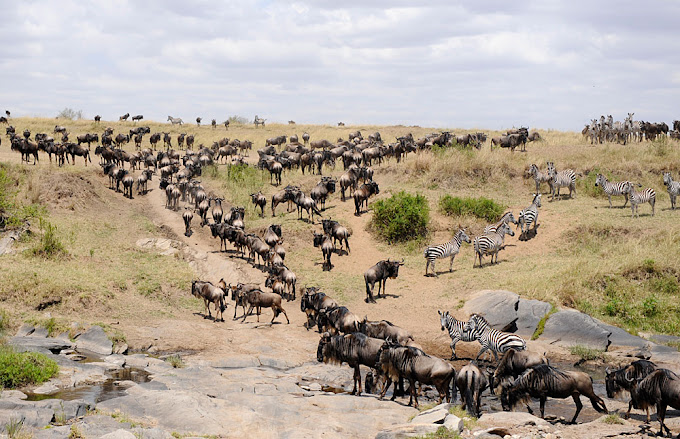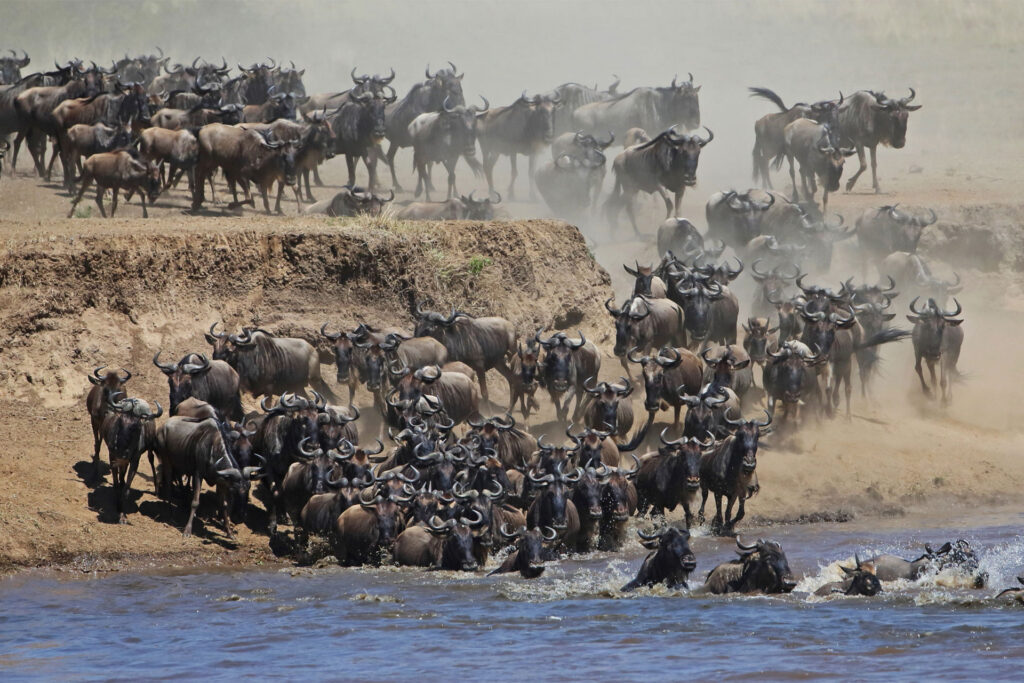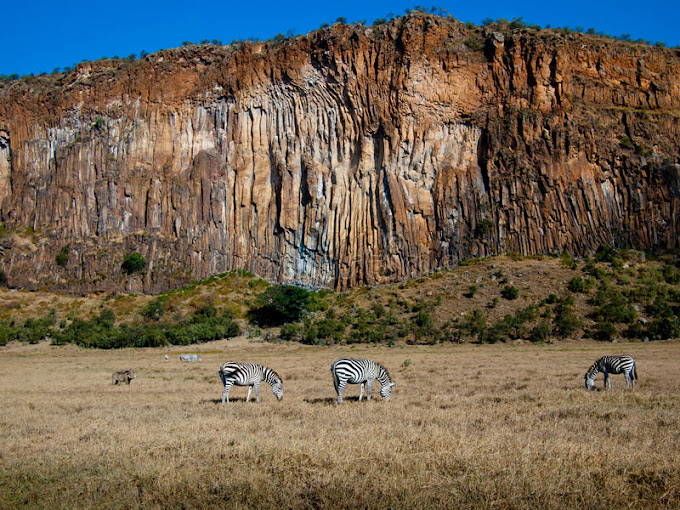Have you ever imagined yourself amidst the untamed wilderness, surrounded by the majestic beauty of Africa?
If you’re a thrill-seeker, exploring the top safaris in Kenya probably sets your heart racing. Sarah, an adventurous and eco-conscious traveler, seeks a vacation and an immersive experience in the wild.
She’s drawn to the allure of Kenya’s famous safari parks, where the vibrant tapestry of wildlife and culture promises the adventure of a lifetime.
This article will take you through Kenya’s most spectacular safari destinations.
From witnessing the Great Migration in the Maasai Mara to walking alongside giraffes on Crescent Island, each destination offers a unique window into the heart of Africa.

A Detailed Explanation of Kenya’s Safari Wonders
Kenya, a land of diverse landscapes and abundant wildlife, is a haven for safari enthusiasts. Here’s everything else you need to know to plan your ultimate Kenyan safari adventure.
Maasai Mara National Park: A Wildlife Spectacle
The Great Migration: A Natural Wonder

The Maasai Mara National Park is the pinnacle of top safaris in Kenya, renowned for the Great Migration.
This extraordinary event, where millions of wildebeest, zebra, and gazelle journey across the savannah, is a spectacle of nature’s grandeur.
Recognized as one of the Seven New Wonders of the World, it offers an unmatched wildlife viewing experience, deeply etching itself in the memories of those who witness it.
Beyond the Migration: The Big Five and More
In the Maasai Mara, every safari is an exploration into the wild unknown.
The park’s vast grasslands, peppered with acacia trees, are the stage for some of the most thrilling wildlife interactions.
Beyond the Great Migration, the Mara is a year-round habitat for the Big Five – lions, leopards, elephants, buffalo, and rhinos. Its reputation for big cats, particularly lions and elusive leopards, marks it as a highlight of the best safari in Kenya.
A Photographer’s and Nature Lover’s Paradise

The Maasai Mara is a haven for photographers and nature enthusiasts. The park’s golden sunrises and sunsets create mesmerizing backdrops for wildlife, offering perfect photo opportunities.
The Mara River, crucial for the migration, is home to hippos and crocodiles, adding an element of excitement to the safari experience.
Also read: Exploring the Majestic Masai Mara Landscape: A Journey of Discovery
Cultural Richness: The Maasai Heritage
The Maasai Mara is more than a wildlife sanctuary; it’s a cultural gem.
Named after the Maasai people, known for their unique traditions and attire, the park offers visitors a chance to explore Maasai villages.
This cultural immersion adds depth to the Kenyan safari experience, showcasing the harmonious coexistence of wildlife and local traditions.
The Maasai Mara National Park transcends being a mere safari destination. It’s a vibrant ecosystem where wildlife and culture intertwine, providing a comprehensive glimpse into Africa’s heart. Whether it’s experiencing the Great Migration, encountering the Big Five, or delving into Maasai culture, the Mara is a testament to Kenya’s status as a host to some of the world’s most famous safari parks.
Samburu National Reserve: The Untamed North
Discovering the Samburu Special Five
In the remote, unspoiled landscapes of northern Kenya, the Samburu National Reserve emerges as a hidden gem among top safaris in Kenya.
This reserve is celebrated for its ‘Samburu Special Five’ – a group of rare and unique species including the Grevy’s zebra, Somali ostrich, reticulated giraffe, gerenuk, and Beisa oryx.
These species, endemic to this region, provide a unique wildlife viewing experience, differentiating Samburu from other famous safari parks in Kenya.
A Contrast to the Mara’s Grasslands
Samburu’s terrain presents a striking contrast to the lush grasslands of the Maasai Mara. Its semi-arid landscape, characterized by rugged terrain and sparse vegetation, is bisected by the life-giving Ewaso Ng’iro River.
This river not only sustains the reserve’s diverse wildlife but also creates a picturesque oasis in the midst of the arid surroundings, making it a highlight for those seeking the best safari in Kenya.
The Ewaso Ng’iro River: A Lifeline in the Wilderness

The Ewaso Ng’iro river, flowing through the heart of Samburu, is a vital water source in this arid region. It attracts many wildlife, especially during the dry season, offering spectacular game viewing opportunities.
The riverbanks are frequented by elephants, lions, and leopards, providing an intimate and thrilling safari experience. Birdwatchers will also find this area a paradise, with numerous bird species adorning the riverine forest.
Embracing the Wilderness of Samburu
Samburu National Reserve, with its unique wildlife and dramatic landscapes, offers an authentic safari experience.
It’s a place where the untamed beauty of nature is on full display, inviting adventurers to explore its hidden wonders.
Whether it’s witnessing the rare Samburu Special Five, marveling at the landscape’s rugged beauty, or enjoying the tranquility along the Ewaso Ng’iro river, Samburu stands as a testament to the diverse and rich safari experiences that Kenya offers.
Crescent Island: A Walk with Wildlife
An Unfenced Encounter with Nature

Aerial view of Lake Naivasha’s Crescent Island
Crescent Island, nestled in the tranquil waters of Lake Naivasha, presents a unique facet of top safaris in Kenya.
Unlike the typical game drives, this small, private sanctuary offers a rare opportunity to walk freely among wildlife.
Here, you can stroll alongside giraffes, zebras, and wildebeests, experiencing the thrill of being close to these magnificent creatures without barriers. This intimate encounter with wildlife is a serene escape from the conventional safari experience and highlights the diversity of Kenya’s safari offerings.
The Charm of Lake Naivasha
Lake Naivasha, the freshwater lake that houses Crescent Island, adds to the allure of this destination. The lake’s rich avian life and scenic beauty make it a perfect spot for birdwatching and photography.
As you explore Crescent Island, the backdrop of the shimmering Lake Naivasha enhances the experience, creating a peaceful harmony between land and water.
This setting is a haven for wildlife and a retreat for those seeking a moment of tranquility amidst nature.
A Safe Haven for Wildlife
Crescent Island is a predator-free zone, allowing for the safe roaming of herbivores and providing a sanctuary.
This aspect makes it an ideal location for families and individuals who wish to experience wildlife in a more relaxed and safe environment.
The absence of predators also means that visitors can observe the natural behavior of these animals up close, making it a unique educational experience.
Connecting with Nature on Foot
Exploring Crescent Island on foot offers a more personal and engaging way to connect with nature.
Walking safaris allow for a slower pace, giving visitors the chance to observe the smaller details of the ecosystem that are often missed during vehicle-based safaris.
This immersive experience is what makes Crescent Island a must-visit for those looking to add a distinctive chapter to their Kenyan safari adventure.
Crescent Island in Lake Naivasha offers a unique and intimate wildlife experience. It stands out as a peaceful, walking safari destination amidst Kenya’s more traditional, vehicle-based safari locations.
Whether it’s for the close encounters with giraffes and zebras or the serene beauty of Lake Naivasha, Crescent Island is a testament to the varied and rich experiences that Kenyan wildlife conservation efforts have nurtured.
Also read: Top 5 Game Reserves in Kenya: Hidden Gems
What Should I Pack for a Safari in Kenya?
Clothing Essentials for Comfort and Protection
When packing for a safari in Kenya, comfort and practicality should be your guiding principles.
Opt for lightweight, breathable clothing that can handle the warm daytime and cooler evenings.
Neutral colors like khaki, brown, and green are recommended as they blend well with the natural environment and are less likely to attract insects.
Long-sleeved shirts and trousers offer protection from the sun and insects, making them essential for your Kenyan safari adventure.
Gear for Wildlife Viewing and Photography

Image: Hell’s Gate Kenya
A pair of high-quality binoculars is a must-have to enhance your wildlife viewing experience.
For those interested in photography, a good camera with a zoom lens will help capture stunning landscapes and wildlife encounters. Remember, the best safari in Kenya is often about the details, so having the right gear can make all the difference in how you experience and document your journey.
Personal Comfort and Health Items
Remember to pack a wide-brimmed hat and high-SPF sunscreen to protect yourself from the intense African sun.
Insect repellent is crucial to keep mosquitoes and other bugs at bay, especially in the evenings. It’s also wise to bring a reusable water bottle to stay hydrated during long game drives.
Preparing for Varied Weather Conditions
Kenya’s weather can vary, so packing layers is key. Early mornings and evenings can be cool, so include a warm fleece or jacket.
A lightweight raincoat or poncho is also advisable, especially if you’re traveling during the rainy season. This way, you’re prepared for any weather conditions while exploring famous safari parks in Kenya.
Miscellaneous Essentials
Lastly, consider packing a small first-aid kit, a flashlight or headlamp, and extra batteries or a portable charger for your electronic devices.
These items will ensure your comfort and safety, allowing you to fully immerse yourself in the wonders of Kenyan wildlife conservation and the unparalleled safari experience.
Embracing Sustainable Tourism in Kenya’s Safaris
Sustainable tourism is increasingly becoming a pivotal aspect of wildlife adventures, especially in destinations like Kenya, renowned for its top safaris.
This approach not only enhances the safari experience but also ensures the conservation of the incredible biodiversity and natural beauty that Kenya is famous for.
The Role of Eco-Lodges and Camps
In Kenya, numerous eco-lodges and camps are leading the way in sustainable tourism. These establishments are designed to minimize environmental impact while providing a comfortable and immersive safari experience.
They often use renewable energy sources, implement waste reduction practices, and provide eco-friendly amenities.
By staying in these lodges, visitors support businesses that prioritize the health of the planet and the well-being of local wildlife.
Community Involvement and Empowerment
Sustainable tourism in Kenya also involves the active participation of local communities.
Many safari tours include visits to local villages, where travelers can learn about the culture and traditions of the indigenous people.
This cultural exchange not only enriches the safari experience but also supports community development and empowerment. It’s a way for visitors to understand the intricate connection between the people and the wildlife, and how their choices can impact conservation efforts.
Wildlife Conservation Efforts
Kenya’s safari industry plays a crucial role in wildlife conservation. By choosing safaris that are committed to ethical and sustainable practices, tourists contribute to the protection of endangered species and habitats.
This includes supporting anti-poaching initiatives, wildlife research, and habitat restoration projects.
As a result, travelers not only enjoy the beauty of Kenya’s natural landscapes and wildlife but also become part of the vital effort to preserve them for future generations.
In embracing sustainable tourism, visitors to Kenya’s safaris can responsibly enjoy the wonders of the African wilderness.
This approach ensures that the best safari in Kenya is about the thrill of wildlife encounters and preserving these experiences for the future. It’s a commitment to traveling with a purpose, where every safari adventure contributes to the greater good of Kenya’s natural heritage.
Top safaris in Kenya: The Tested and Proven Camps in the Wild
1.Sarara Camp, Samburu

Located in the Namunyak Wildlife Conservancy in northern Kenya, Sarara Camp is one of the top safaris in Kenya that offers a unique wilderness experience.
This six-tent camp is known for its dramatic arrival via light aircraft, gliding through the Mathews Range. Visitors can witness elephants from as far as Ethiopia at the camp’s infinity pool and encounter reticulated giraffes on horseback rides.
The nearby Reteti Elephant Orphanage, a community partnership, is a highlight, offering insights into local wildlife conservation efforts.
2. Kicheche Bush Camp, Maasai Mara:
An award-winning camp in the Olare Motorogi Conservancy, Kicheche Bush Camp is one of the top safaris in Kenya. It is adjacent to the Maasai Mara National Reserve.
It’s a favorite among top wildlife photographers for its significant big-cat population and excellent game viewing opportunities.
The camp features eight luxurious canvas tents and is known for its expert guides, communal dining, and family-like atmosphere.
3. Asilia Rekero Camp, Maasai Mara
Overlooking the Talek River in the Maasai Mara National Reserve, Asilia Rekero Camp is one of the top safaris in Kenya that’s ideally positioned for the wildebeest migration.
The camp offers nine rustic tents, several with river views, and a wooden dining deck for prime wildlife watching. It’s a hotspot for photographers, offering specialized vehicles for low-angle shots.
4. Lewa House, Lewa Conservancy
Situated in one of Kenya’s finest conservation areas, Lewa House is one of the top safaris in Kenya that offers a classic Kenyan safari experience.
The lodge features fairytale stone cottages and is known for its family-friendly atmosphere. Guests can join rangers in anti-poaching training sessions and visit Lewa’s control center to learn about conservation efforts.
5. Lengishu House, Borana Conservancy
Lengishu House is an exclusive-use property in the scenic Borana Conservancy, accommodating up to 12 guests.
The house is one of the top safaris in Kenya that’s decorated with a blend of African fabrics, antique tapestries, and curio store finds.
It offers soul-stirring views and includes a game-drive vehicle and guide. Visitors can arrange sundowners on nearby Lion Rock, a site made famous by Disney’s “The Lion King.”
These locations offer diverse experiences, from intimate wildlife encounters to cultural insights, making them top choices for safaris in Kenya.
Final Thoughts
As we conclude our exploration of the top safaris in Kenya, it’s clear that each destination, from the famous Maasai Mara to the untamed Samburu, offers a distinct and unforgettable window into Africa’s wild heart.
For someone like Sarah, who craves adventure and a deep connection with nature, these safaris are more than just a trip; they are a journey into the soul of the wilderness.
Whether you’re drawn to the dramatic spectacle of the Great Migration, the unique wildlife of the Samburu Special Five, or the serene walks with giraffes on Crescent Island, Kenya’s safaris are a mosaic of awe-inspiring experiences.
So, pack your spirit of adventure, bring along your camera, and prepare for an expedition that will etch itself into your heart forever, offering a transformational encounter with nature’s grandeur, not just a getaway.
FAQs About Top Safaris in Kenya
1. What is the best time to visit Maasai Mara for the Great Migration?
The best time is from July to October, when the wildebeest migration is in full swing.
2. Can I experience a safari in Kenya on a budget?
Yes, various budget-friendly options are available, including camping and affordable lodges.
3. Are walking safaris safe in Kenya?
Walking safaris, like the one on Crescent Island, are safe and guided by experienced rangers.
4. Is Wildlife Conservation a Part of Kenyan Safaris?
Yes, wildlife conservation is a significant aspect of Kenyan safaris.
Many safari camps and lodges actively participate in conservation efforts, including anti-poaching initiatives and community-based conservation projects.
5. What Makes Samburu National Reserve Unique?
Samburu National Reserve is unique for its ‘Samburu Special Five’ – rare species like the Grevy’s zebra and reticulated giraffe.
Its semi-arid landscape offers a different safari experience compared to the lush Maasai Mara, making it a must-visit for those seeking the best safari in Kenya.
6. How Can I Ensure My Safari is Eco-Friendly?
Choose lodges and camps that practice sustainable tourism to ensure an eco-friendly safari. Look for accommodations that use renewable energy, support local communities, and have wildlife conservation programs.
7. Are Kenyan Safaris Suitable for Families?
Yes, many safari destinations in Kenya are family-friendly. They offer educational activities for children, such as junior ranger programs, and accommodations that cater to families.
8. What Should I Pack for a Safari in Kenya?
Essential items for a Kenyan safari include comfortable clothing, a hat, sunscreen, binoculars, a camera, and insect repellent. It’s also advisable to bring layers for cooler mornings and evenings.
9. Can I Combine a Beach Holiday with My Safari in Kenya?
Absolutely! Kenya offers beautiful coastal destinations like Diani Beach, which can be easily combined with a safari trip.
10. Is it Safe to Travel to Kenya for a Safari?
Kenya is generally safe for tourists, especially within the safari areas. However, it’s always wise to follow travel advisories, use reputable tour operators, and take standard safety precautions when traveling.


